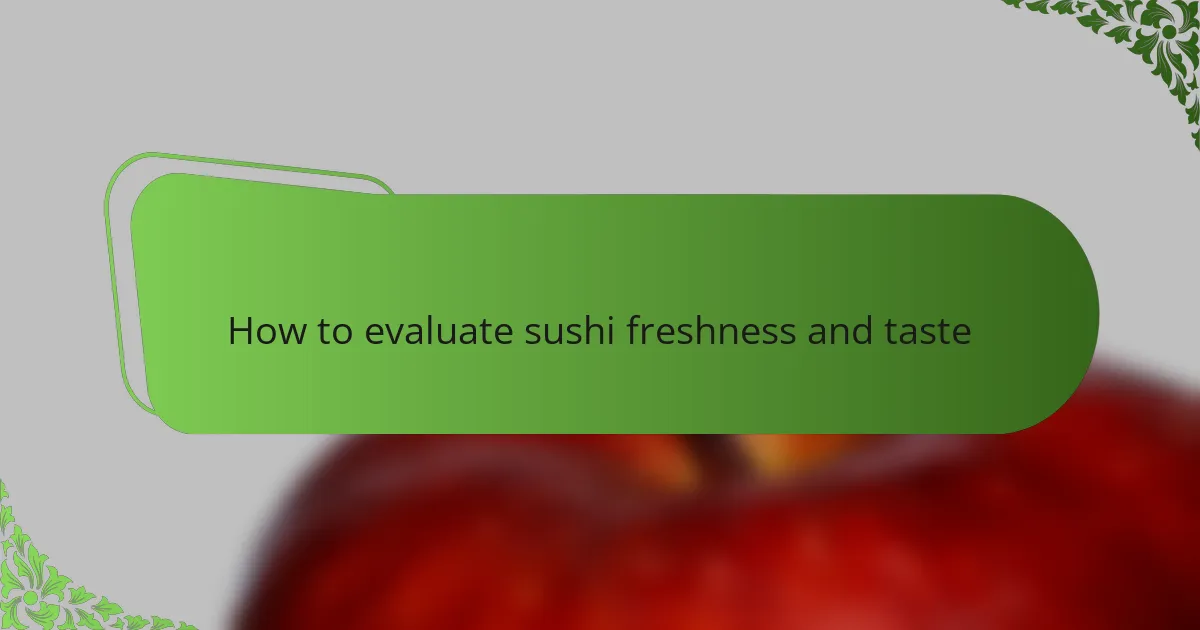Key takeaways
- Quality sushi is defined by the chef’s skill in balancing flavors, the handling of ingredients, and the overall dining experience, elevating it to an art form.
- A great omakase experience involves an intimate connection with the chef, thoughtful pacing, and authentic storytelling that enhances the meal’s significance.
- Fresh sushi is characterized by glistening appearance, clean flavors without aftertaste, and the perfect texture, indicating precise craftsmanship.
- When choosing an omakase meal, communicate preferences to the chef, focus on variety and pacing, and consider the atmosphere for a tailored dining experience.

Understanding quality in sushi restaurants
Quality in sushi restaurants goes beyond just fresh fish; it’s about the harmony of flavors, the skillful knife work, and the delicate balance between rice and topping. I’ve often wondered why some places leave a lasting impression while others don’t, and for me, it always comes down to those subtle details that only a seasoned chef can master.
When I first started exploring high-end sushi spots, I realized that quality is also about how the chefs treat their ingredients—do they handle the fish with respect, season the rice just right, and serve each piece at the perfect temperature? Experiencing this made me appreciate sushi not just as food, but as an art form.
Do you think quality can be measured by ripeness or origin alone? In my experience, it’s more nuanced—quality is a feeling you get with every bite, the kind of thoughtful craftsmanship that transforms simple ingredients into an unforgettable dining experience.

Key elements of a great omakase experience
What truly defines a great omakase experience for me is the intimate connection with the chef and the story they tell through each piece. Have you ever noticed how the anticipation builds as they carefully present every bite? That moment of trust, when you surrender to their expertise, makes the whole experience feel special and personal.
The pacing of the meal is another crucial element I’ve come to value deeply. It’s not just about quantity but the rhythm—the thoughtful pause between courses lets you savor the flavors and prepares your palate for what’s next. This balance keeps me engaged throughout, turning the tasting into a memorable journey rather than a race to finish.
Finally, I think a sense of authenticity elevates the omakase beyond just fine dining. When the chef shares insights about the ingredients or their technique, it creates a connection that goes beyond taste. I’ve found these small moments of storytelling make the experience richer and more meaningful, almost like learning a secret language of sushi.

How to evaluate sushi freshness and taste
When I evaluate sushi freshness, the first thing I look for is the fish’s appearance—it should glisten, never look dull or dry. Have you ever noticed how fresh fish almost seems to glow under the restaurant’s lights? That subtle sheen tells me the chef started with top-notch ingredients, which instantly raises my expectations for the whole meal.
Taste-wise, freshness reveals itself through clean, bright flavors without any fishy aftertaste. I remember once biting into a piece that was so fresh the delicate flavors seemed to unfold like a story on my tongue—no heaviness, just pure, lively ocean essence. That kind of taste makes all the difference between a good sushi and an unforgettable one.
Another sign I pay attention to is the texture; the fish should feel tender yet firm, not mushy or overly soft. Have you ever caught yourself savoring how the fish melts gently but holds its shape in your mouth? That balance reflects not only freshness but also the chef’s precise handling, which truly elevates the sushi experience for me.

Atmosphere and service at omakase venues
Walking into an omakase venue, I immediately sense a calm yet anticipatory atmosphere, as if the room itself invites you to slow down and truly experience each moment. Have you noticed how the minimalist décor and soft lighting create a kind of sacred space where every detail feels intentional? That quiet focus enhances my appreciation for the craftsmanship unfolding before me.
Service at these spots always strikes me as quietly attentive—never intrusive but deeply respectful. I recall one time when the chef noticed my curiosity about a rare fish and took a moment to explain its origin without rush, making me feel like a guest rather than just a customer. Those personal touches transform the meal into a shared experience, building trust and connection.
What’s fascinating is how the pace of service complements the atmosphere perfectly; there’s a natural rhythm that flows effortlessly from one course to the next. Waiting just long enough between bites, I find, heightens my anticipation and sharpens my senses, turning the service into an integral part of the overall enjoyment.

My personal experience at Omakase
Sitting at the counter at Omakase, I immediately felt a sense of anticipation mixed with comfort. Have you ever experienced that moment when the chef’s hands move with such confidence, it feels like watching a well-rehearsed performance? That evening, each bite seemed to tell a story crafted just for me.
What struck me most was how the flavors unfolded gradually, almost like chapters in a book. I remember pausing after a particularly delicate piece, savoring it fully, and realizing that this wasn’t just about taste—it was about connection. The chef’s quiet passion was evident in every detail, from the texture of the rice to the subtle seasoning of the fish.
I also appreciated how the pacing allowed me to truly absorb the experience without feeling rushed. Has there ever been a moment in dining when time seems to slow down, and you become fully present? For me, that’s the essence of Omakase—it’s not just a meal, but an intimate journey guided by expert hands.

Highlights of the Omakase menu
One highlight that instantly stays with me at Omakase is the diversity and precision of the nigiri selection. Each piece is crafted with such care—the balance between the vinegared rice and the topping is flawless, and the fish often has subtle seasoning that enhances without overpowering. Have you ever bitten into a piece so simple yet complex it feels like a little revelation? That’s what happened to me here.
I also can’t forget the moment the chef presented a standout special, like a lightly torch-seared toro. The creamy richness combined with the smoky hint was a perfect contrast to the cooler, fresher bites earlier in the meal. It reminded me how omakase is as much about contrast and surprises as it is about consistency. These thoughtful variations kept me eagerly anticipating what would come next.
Lastly, the subtle attention to texture throughout the menu made a lasting impression. From the crisp snap of a fresh shrimp to the melt-in-your-mouth softness of aged fish, I found myself tuning into sensations I hadn’t noticed before. Isn’t it fascinating how quality shows itself not only in taste but in how food feels? At Omakase, that tactile journey was just as memorable as the flavors.

Tips for choosing your own omakase meal
Choosing your own omakase meal can feel daunting at first—how do you know what to pick when the menu isn’t laid out in detail? From my experience, the best approach is to trust the chef’s recommendations but don’t hesitate to share your preferences or dietary restrictions upfront. I’ve found that a brief chat often shapes the meal in a way that feels both personal and satisfying.
I also suggest paying close attention to the pacing and variety offered. Have you ever noticed how a well-curated omakase balances textures and flavors to keep your palate intrigued throughout? When I’ve selected dishes that mix lighter and richer bites, the meal feels like a thoughtful story unfolding rather than just a sequence of plates.
Lastly, consider the atmosphere and your own mood when choosing. Sometimes, I lean toward simpler, more traditional options to really savor the craftsmanship, while other times I’m eager for creative twists. Reflecting on what you want from the experience helps turn your omakase into a memorable journey tailored just for you.



